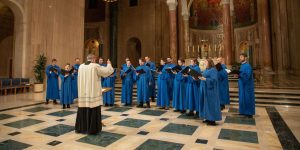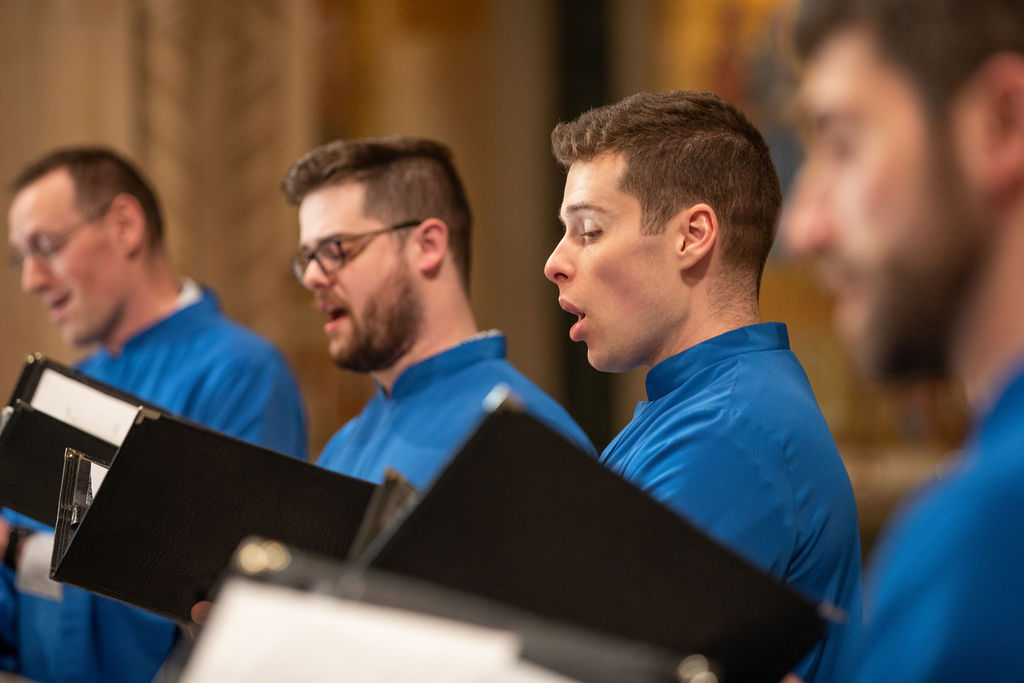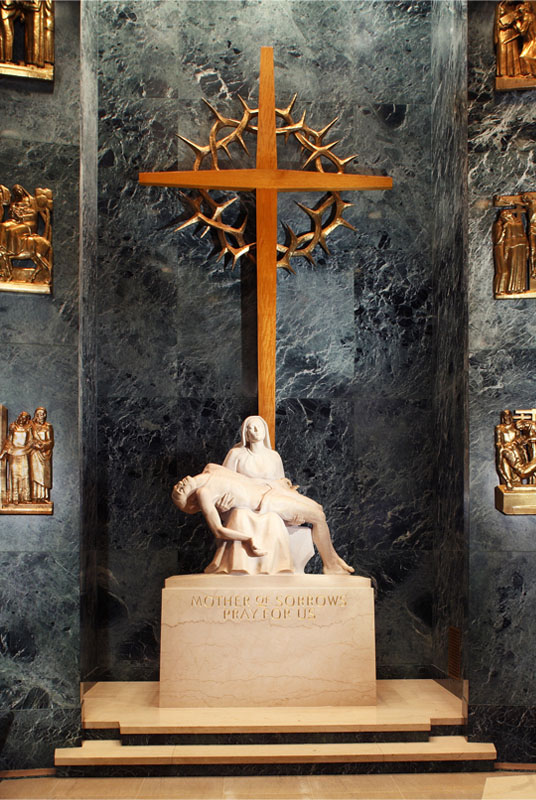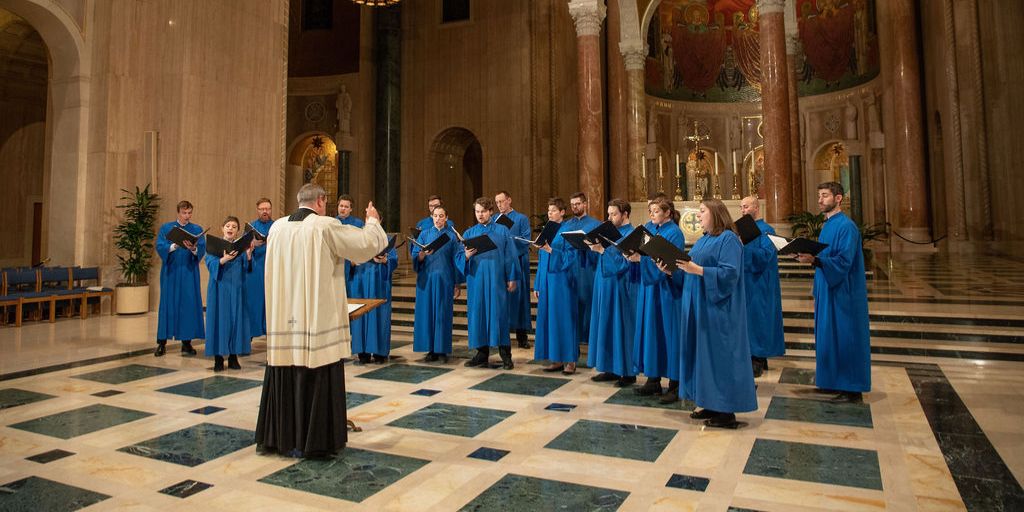
From the desk of Dr. Peter Latona, Director of Music
Angels are not simply messengers of God’s mercy; they serve as a bridge between heaven and earth, guiding the soul’s journey to paradise.
This truth is the guiding theme of the Choir of the Basilica’s 2025 All Souls’ Day concert, entitled “In the Company of Angels.” Through centuries of sacred music, the concert unfolds as a spiritual arc, mirroring our pilgrimage to the heavenly realm where we shall praise Christ endlessly in the company of angels. It opens with longing and pleas for intercession, journeying through grief, hope in the Cross, redemption, Resurrection, and finally, eternal praise in the company of the heavenly hosts.
As the Church commemorates All Souls’ Day, we pause to remember the departed and to pray for their eternal rest in God’s presence. In today’s post, we invite you to enter this remembrance through the language of music, exploring the concert’s themes of angels, divine worship, and the promise of eternal life.
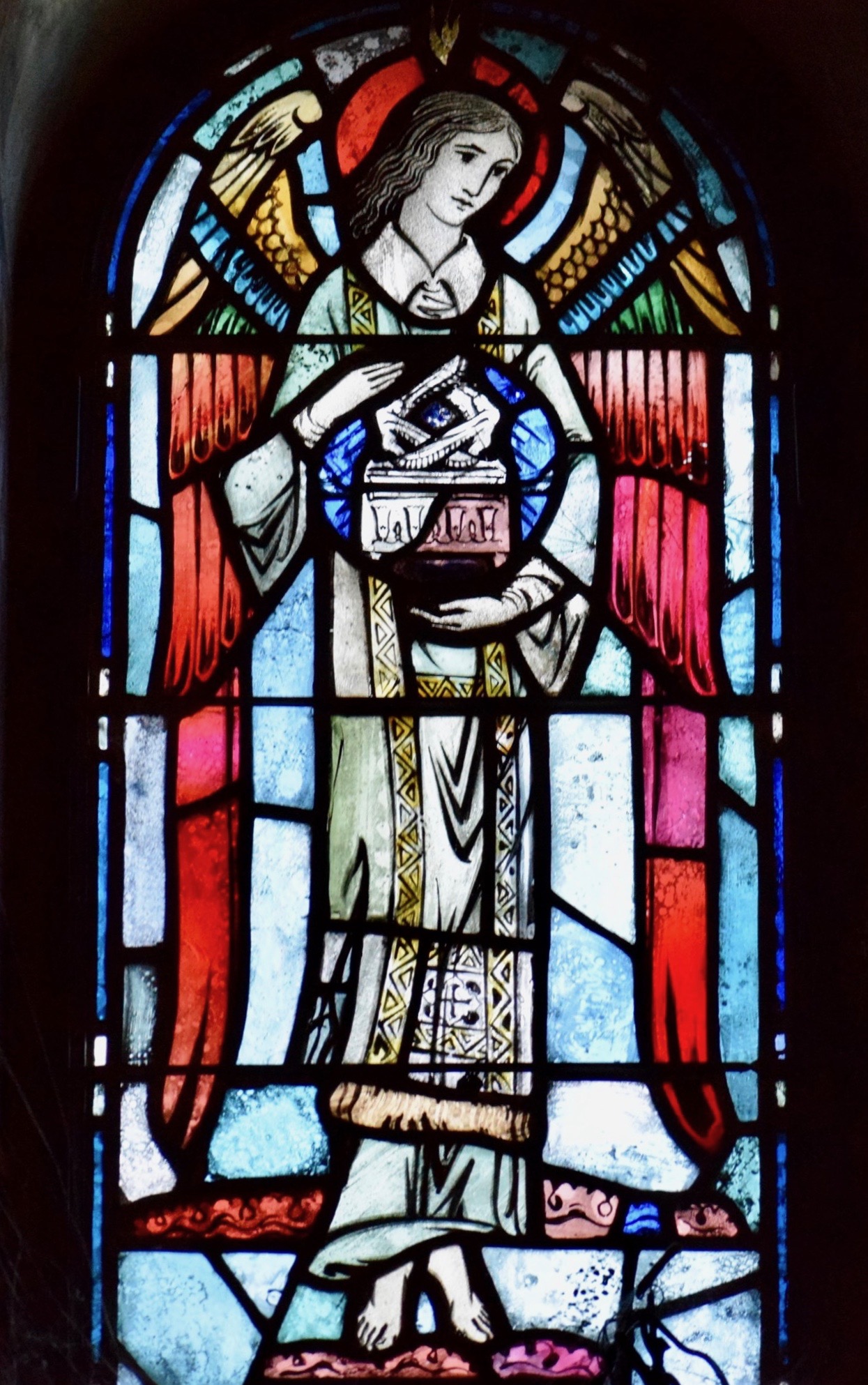
One Thing I Ask of the Lord – Peter Latona (b. 1968)
The concert opens with a plea and a petition: a simple antiphon I composed for the 25th anniversary of the death of Saint Teresa of Calcutta called One Thing I Ask of the Lord. This piece uses text from Psalm 27 to voice the soul’s deepest desire “to dwell in the house of the Lord all the days of my life.”
Salvator mundi – Giovanni Pierluigi da Palestrina (1525–1594)
The second piece, a Renaissance-era work translated as “Savior of the World,” pleads to Christ for salvation by invoking the intercession of the Holy Mother of God, ranks of angels, and all categories of saints, each mentioned by name.
Duo Seraphim – Jacob Handl (1550–1591)
Like the quintessential hymn of praise the Sanctus, Jacob Handl’s Duo Seraphim reflects the angels’ role of praising God continually. Written for double choir, the piece paints Isaiah’s vision of the Seraphim calling to one another: “Sanctus, sanctus, sanctus, Dominus Deus Sabaoth.” Each choir answers the other in cascading waves of sound — a musical image of the heavenly host praising God in unending song.
Sanctus from Messe à trois voix – André Caplet (1878–1925)
It is said that Claude Debussy called André Caplet his “Angel of Corrections” because of all the assistance he provided in editing and completing Debussy’s orchestrations. Like Debussy, Caplet used harmonic color to give his compositions a mystical dimension — and in the Sanctus, this otherworldly quality creates imagery of the praises of the heavenly host.
Für Jan van Eyck – Arvo Pärt (b. 1935)
Für Jan van Eyck was composed for the 2020 dedication of the restored Ghent Altarpiece by 15th-century Flemish painter Jan van Eyck. Located in Belgium’s Saint Bavo Cathedral, this large and complex polyptych is considered a masterpiece of Renaissance art, renowned for its pioneering technique and realism. Consisting of 20 panels, it depicts complex theological themes and symbols with striking detail and narrative depth.
As a contemporary Estonian composer, Arvo Pärt offers a moment of contemplation for this altarpiece characterized by a musical minimalism. While this may seem incongruous with the richness of the altarpiece, the musical effect creates space for beauty to reveal itself, guiding the listener to focus on the central image of the altarpiece: the Lamb of Sacrifice who takes away the sins of the world.
Sicut cervus – Cipriano de Soto (Ziprianus) (fl. 1560)
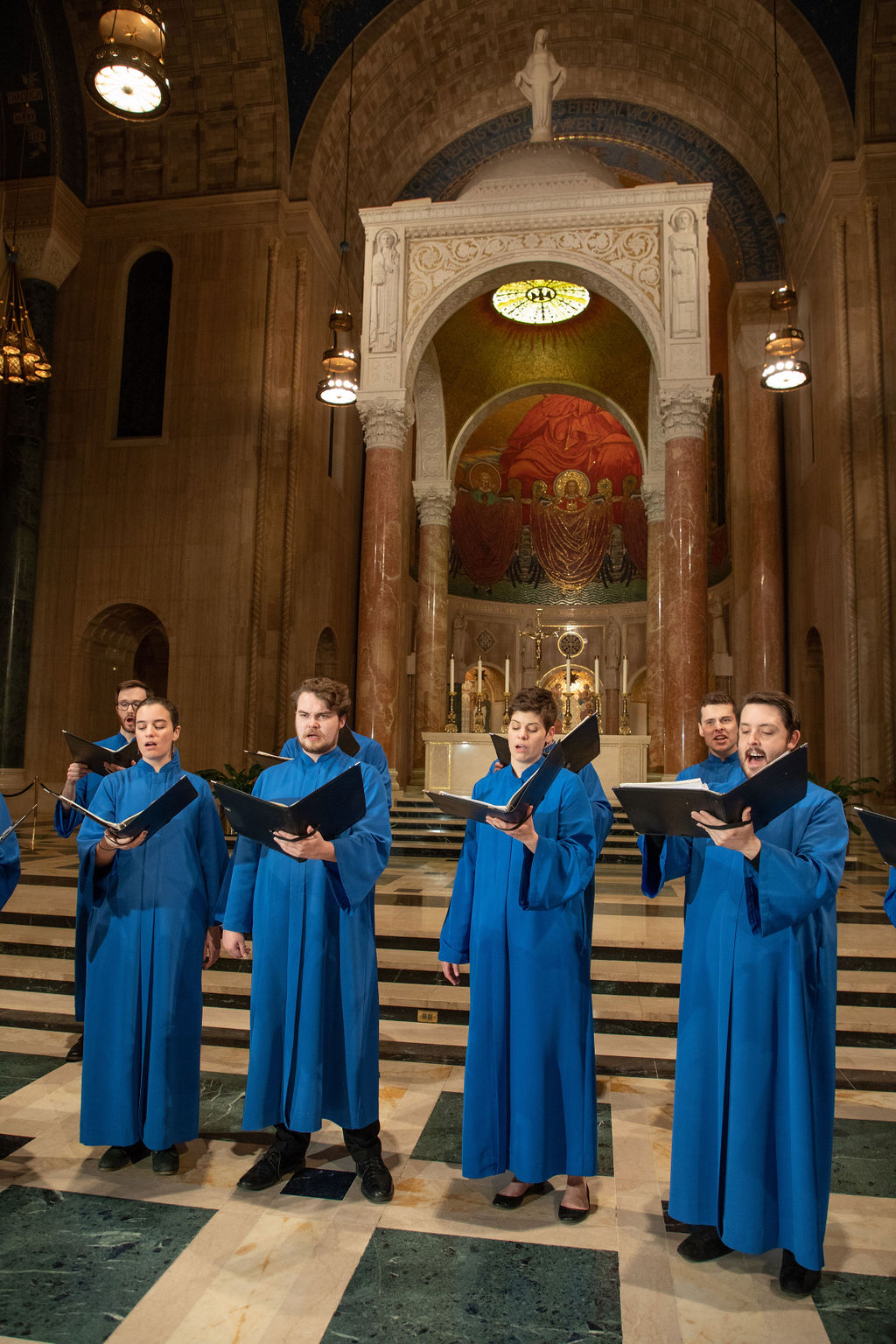 A gem of Spanish Renaissance polyphony, Sicut cervus uses both the text of Psalm 42:1 — “As the deer longs for running streams, so my soul longs for you, O God,” and a penitential declamation — “Miserere mei, Have mercy on me, O Lord.” The text of Sicut cervus was given its most famous setting by the 16th-century composer Palestrina, but the Cipriano setting we have chosen creates a much different mood. While the Palestrina setting expresses a sense of peace and union, this setting evokes a sense of longing through the use of the Phrygian mode.
A gem of Spanish Renaissance polyphony, Sicut cervus uses both the text of Psalm 42:1 — “As the deer longs for running streams, so my soul longs for you, O God,” and a penitential declamation — “Miserere mei, Have mercy on me, O Lord.” The text of Sicut cervus was given its most famous setting by the 16th-century composer Palestrina, but the Cipriano setting we have chosen creates a much different mood. While the Palestrina setting expresses a sense of peace and union, this setting evokes a sense of longing through the use of the Phrygian mode.
O quam amabilis – Palestrina
O quam amabilis is a motet that contemplates the Eucharist — the “Bread of Angels.” Sung by the lower voices, its closing plea, “Grant to your flock salvation and, after life’s end, everlasting joy,” ties the themes of nourishment and eternal life directly to the mystery of faith.
Christ Hath a Garden – Gabriel Rhys Simersion (b. 1998)
In this setting of the traditional Christian hymn Christ Hath a Garden, heaven is imagined as a walled garden tended by Christ himself. The “trees of spice” symbolize the saints, flourishing in God’s grace, while the “wind of heaven” represents the Spirit who fills the garden with divine fragrance. This poetic image of paradise echoes the vision found in Scripture — a place of beauty, communion, and everlasting peace.
A Child’s Prayer – James MacMillan (b. 1959)
Written in memory of the victims of the 1996 Dunblane tragedy, this piece captures the grief and pain of our life on earth in a profound way. In the opening, the choir sings “welcome” on a hauntingly dissonant chord, representing the souls in heaven calling on the souls of the deceased. Meanwhile, two treble soloists — representing the voices of innocence — call out to Jesus, “deep in my heart forever stay.” As the soloists and choir unite on the words “Joy and love,” the music radiates the sound of souls finding peace in heaven’s embrace.
Crux fidelis – Jean Jules Aimable Roger-Ducasse (1873–1954)
At the crux of our hope in eternal life is the fundamental tenet of our faith: the death and Resurrection of Christ. Crux fidelis hails the Cross as the faithful tree of salvation, noble and above all others. As a contemporary of André Caplet, Roger-Ducasse shares a similar Impressionistic and colorful harmonic language characteristic of early 20th-century French composers.
Easter from Five Mystical Songs – Ralph Vaughan Williams (1872–1958)
In Ralph Vaughan Williams’ Easter, Christ’s triumph of Life over death is expressed in a jubilant outpouring of resurrection joy. This setting of the sacred poem by George Herbert perfectly reflects how, as Herbert writes — “The cross taught all wood to resound His name.”
Together, its lines form a poignant reminder that through the Cross comes life eternal: “Rise heart; thy Lord is risen,” for it is thy Lord who “takes thee by the hand that thou likewise with him may’st rise.”
They are at rest – Edward Elgar (1857–1934)
A setting of a text by Saint John Henry Newman, They are at rest revisits the metaphor of heaven as a tranquil garden “where Angelic forms abide.” In this piece, Elgar presents a deeply personal extension of late-19th century Romanticism, where generous chromaticism is tempered by classical diatonic tonality, creating both a sense of grandeur and intimacy. Chromatic harmonies capture the peace of souls who now “see no longer change nor fear,” surrounded by unending praise.
Pie Jesu and In paradisum from Requiem – Gabriel Fauré (1845–1924)
These two movements from Requiem demonstrate the striking communicative nature of Fauré’s simplicity. One, a simple and radiant prayer, asks for eternal rest for the departed, while the other makes an invocation: “May the angels lead you into paradise.”
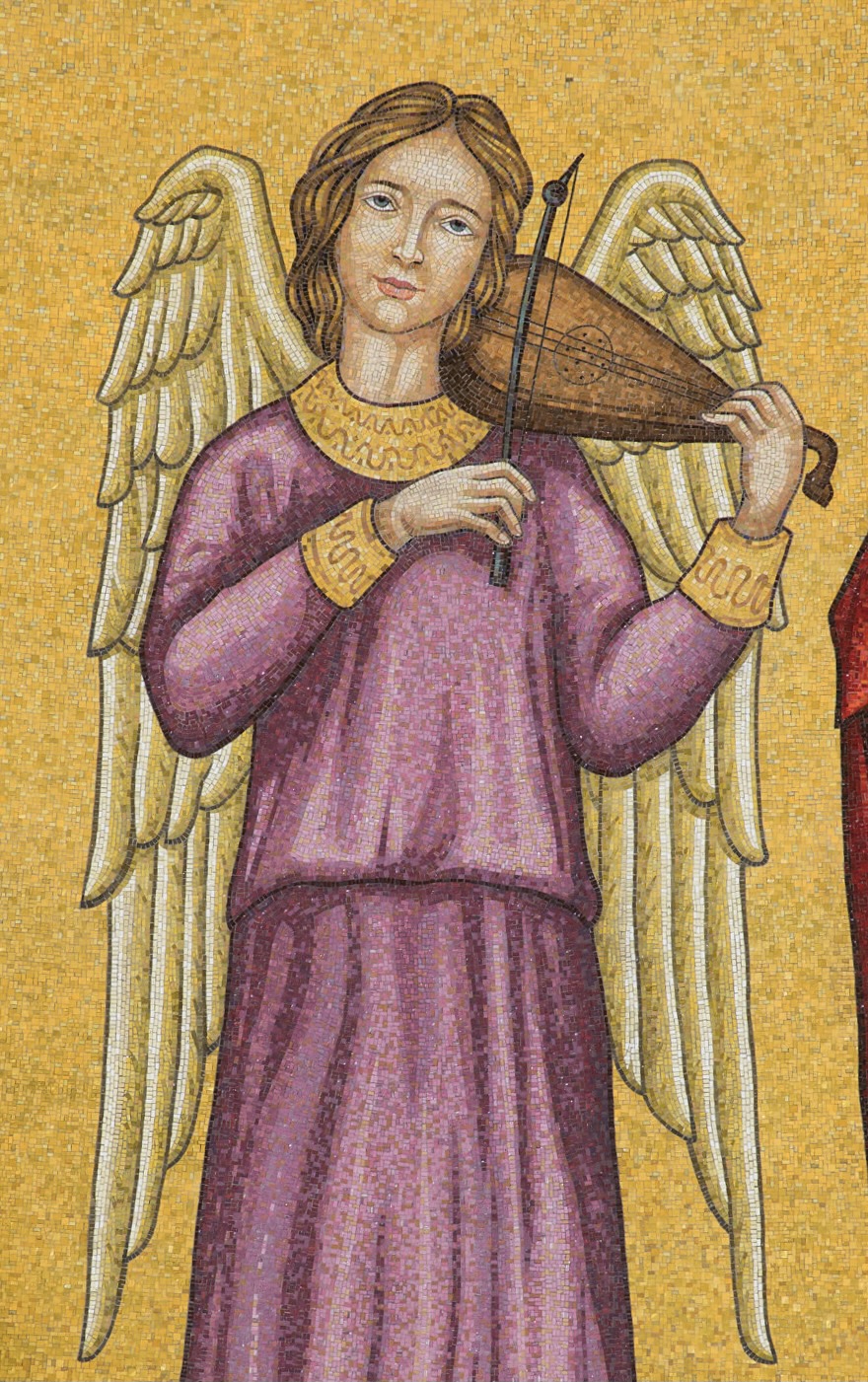
As the final movement of the Requiem, In paradisum evokes the soul’s ascent to heaven accompanied by angels. In complete contrast to the opening movement, here, the transparent texture, arpeggiated accompaniment figure, and absence of a distinct bass line all contribute to the sense of journeying toward the heavenly realm, untethered from the earth.
Te Deum (Collegium Regale) – Herbert Howells (1892–1983)
It is in that heavenly realm that we conclude our program — in the garden of paradise amid trees of spice, where in the company of angels, we sing endlessly. Rather than the Holy, Holy, we sing the Te Deum, a sublime hymn of praise reserved for moments of great joy and celebration. The ancient text is not only a song of praise and thanksgiving, but a declaration of faith expressing hope and trust. Herbert Howells’ resplendent Te Deum (Collegium Regale) captures all the grand and intimate dimensions of the text, with whimsical contrapuntal moments that lead to powerful declamatory unison singing, built upon a chromatic and impressionistic harmonic language.
As we pray for and remember the souls of those who have gone before us, may we take comfort in the grace that unites us with them, not yet beside them in the paradise prepared for us, but even now in the ceaseless praise of God. In our prayer and song here on earth, we are joined to the saints and angels in forming a bridge between heaven and earth, illuminating the path that leads us to our eternal home.
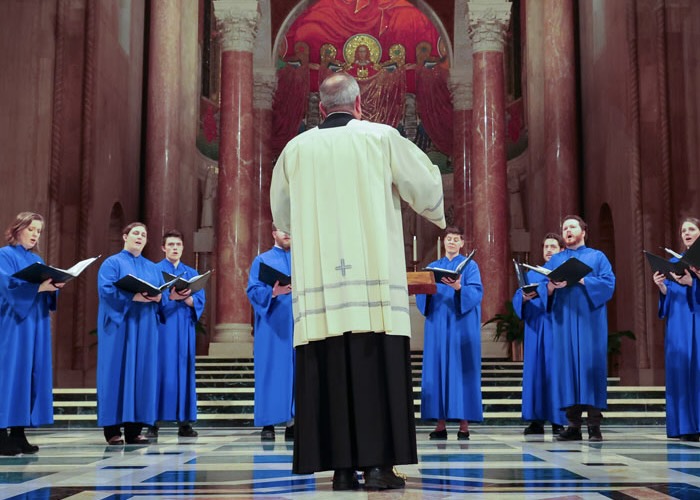 Watch the Concert on November 2
Watch the Concert on November 2
We hope you’ll join us virtually or in person for “In the Company of Angels,” livestreamed from nationalshrine.org/mass/ on November 2 at 6:00 p.m. ET. The concert is free and open to the public. Seating will be on a first-come, first-served basis with no ticketing, advanced registration, or reservations.

